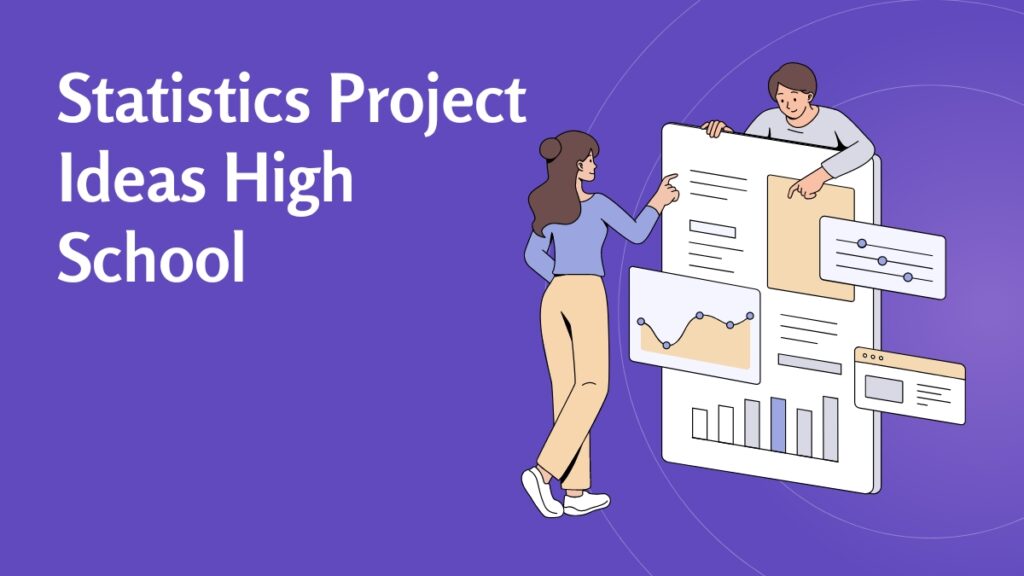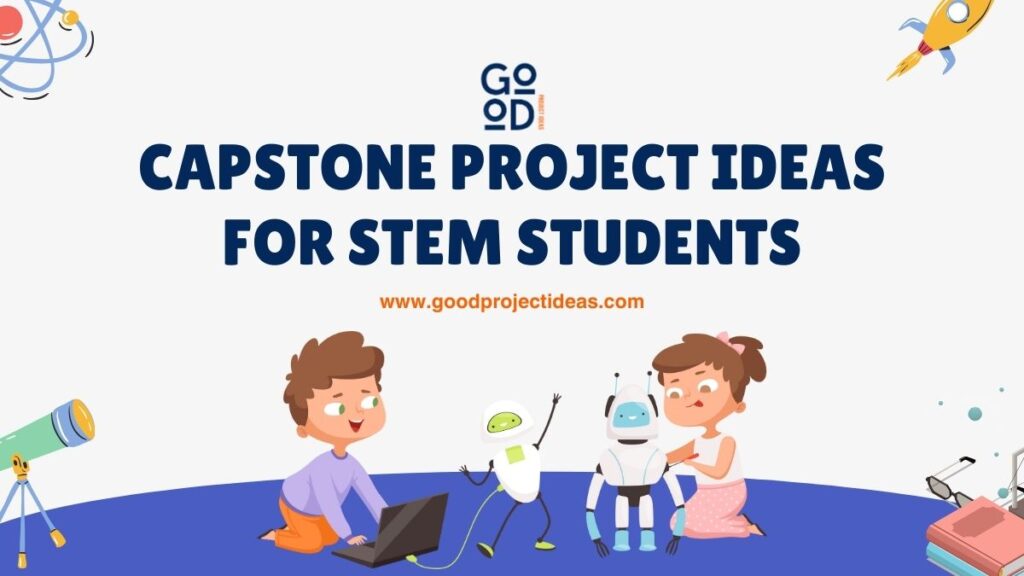Discover fun statistics project ideas high school students! These projects help apply math skills to real-life situations.
High school statistics projects offer a dynamic way to use math skills in everyday life. They help students think critically and solve problems, using numbers to understand the world better.
Students get to conduct surveys and analyze data, applying statistics in practical ways. This guide offers a variety of exciting statistics project ideas designed for high school students to explore and enjoy.
What is Statistics?
Statistics is about understanding data through collection, organization, and analysis. It helps us make sense of information and draw conclusions.
Key Concepts
- Data: Information for analysis.
- Population: Entire group studied.
- Sample: Part of the population.
- Descriptive Statistics: Summarizes data (mean, median, etc.).
- Inferential Statistics: Makes predictions from samples.
- Probability: Likelihood of events happening.
Statistics helps us make decisions and understand trends in various fields, from business to science.
Statistics Project Ideas High School PDF
Importance of statistics in everyday life
The Impact of Statistics
- Informed Choices: Helps choose insurance, investments, and more.
- Understanding Information: Used in news, weather, and polls.
- Business & Economics: Essential for market research and financial analysis.
- Healthcare: Key in medical research and public health.
- Sports & Gaming: Analyzes performance and predicts outcomes.
Statistics turns data into actionable insights.
The role of statistics in academic and professional life
The Role of Statistics
In Academia:
- Research: Helps design and analyze experiments.
- Data Interpretation: Crucial for drawing conclusions.
- Critical Thinking: Boosts analytical skills.
- Problem-Solving: Aids in finding solutions.
In Professional Life:
- Business: Used for market and financial analysis.
- Healthcare: Essential for research and public health.
- Government: Guides policy and resource decisions.
- Marketing: Analyzes consumer behavior.
- Sports: Assesses performance and predicts outcomes.
Statistics is key for making informed decisions and advancing various fields.
Statistics Project Examples PDF
Understanding Statistics Projects
Key Components of a Statistics Project
- Research Question: Define the problem.
- Data Collection: Gather data.
- Data Cleaning: Fix errors.
- Data Analysis: Find patterns.
- Data Visualization: Use graphs and charts.
- Interpretation: Explain results.
- Report Writing: Document findings.
Data Collection Methods
- Surveys: Questionnaires or interviews.
- Experiments: Test variables.
- Observations: Watch and record.
- Secondary Data: Use existing data.
Data Analysis Techniques
- Descriptive Statistics: Mean, median, mode.
- Inferential Statistics: Hypothesis testing, regression.
Visualizing Data
- Graphs: Show patterns and trends.
- Charts: Compare categories or track data over time.
- Tables: Structure data for easy reading.
Understanding these elements helps you plan and execute an effective statistics project.
Choosing a Statistics Project Topic
Refining Your Statistics Project Topic
Specificity
Focus narrowly: Instead of “social media impact on mental health,” use “impact of Instagram on adolescent self-esteem.”
Create a clear, answerable research question.
Data Availability
Check if you can access reliable data.
Decide if you need to collect new data or use existing sources.
Feasibility
Ensure the project fits your timeline.
Assess if you have the necessary tools and resources.
Alignment with Course Objectives
Make sure the topic fits the course curriculum.
Choose a topic that showcases your statistical skills.
Statistics Project Ideas High School
Check out statistics project ideas high school:-
Social Sciences
- Correlation between social media usage and mental health
- Impact of socioeconomic status on educational outcomes
- Analysis of voting patterns in a specific election
- Relationship between crime rates and unemployment
- Public opinion on climate change
- Analysis of marriage and divorce rates
- Correlation between education level and income
- Impact of community programs on youth behavior
- Trends in birth rates over the years
- Analysis of homelessness in urban areas
Health and Medicine
- Correlation between diet and obesity rates
- Effectiveness of different vaccination programs
- Analysis of healthcare costs over time
- Impact of exercise on mental health
- Spread of infectious diseases (e.g., flu, COVID-19)
- Correlation between smoking and lung cancer rates
- Analysis of hospital readmission rates
- Effectiveness of various mental health treatments
- Trends in life expectancy
- Analysis of sleep patterns and health outcomes
Environment
- Impact of climate change on sea levels
- Analysis of air pollution levels in different cities
- Effectiveness of recycling programs
- Water quality analysis in local rivers or lakes
- Trends in renewable energy consumption
- Correlation between deforestation and wildlife populations
- Analysis of carbon footprint in households
- Impact of urbanization on local ecosystems
- Study of endangered species populations
- Analysis of waste production and management
Business and Economics
- Stock market analysis and predictions
- Consumer spending patterns over time
- Impact of advertising on sales
- Analysis of small business success rates
- Trends in online shopping
- Correlation between GDP and unemployment rates
- Analysis of inflation rates
- Effectiveness of different marketing strategies
- Impact of minimum wage changes on employment
- Study of income inequality
Education
- Study habits and academic performance
- Impact of class size on student achievement
- Correlation between attendance and grades
- Analysis of standardized test scores
- Effectiveness of online learning vs. traditional learning
- Trends in dropout rates
- Impact of extracurricular activities on academic performance
- Analysis of teacher evaluation methods
- Study of student stress levels
- Correlation between parental involvement and student success
Sports
- Performance analysis of professional athletes
- Effectiveness of different training methods
- Injury rates in specific sports
- Impact of fan attendance on team performance
- Analysis of sports betting odds
- Correlation between age and athletic performance
- Study of athlete nutrition and performance
- Analysis of game strategies
- Trends in sports participation
- Impact of weather conditions on game outcomes
Technology
- Trends in smartphone usage
- Impact of social media on communication
- Analysis of internet usage patterns
- Effectiveness of cybersecurity measures
- Study of technology addiction
- Trends in e-commerce
- Correlation between technology use and productivity
- Analysis of online learning tools
- Impact of technology on job markets
- Study of digital divide
Science
- Plant growth under different light conditions
- Analysis of chemical reaction rates
- Study of genetic variations in populations
- Impact of pollution on plant growth
- Analysis of energy consumption
- Correlation between temperature and reaction time
- Study of biodiversity in local areas
- Impact of fertilizers on soil quality
- Analysis of renewable energy sources
- Study of weather patterns
Psychology
- Correlation between stress levels and academic performance
- Impact of sleep on cognitive function
- Study of personality traits and career choices
- Analysis of memory retention techniques
- Effectiveness of different study methods
- Impact of color on mood
- Study of social behavior in groups
- Analysis of decision-making processes
- Correlation between self-esteem and social media usage
- Study of phobias and their prevalence
Transportation
- Analysis of traffic patterns
- Impact of public transportation on urban mobility
- Study of car accident rates
- Trends in fuel consumption
- Effectiveness of carpooling programs
- Analysis of transportation costs
- Study of commute times
- Correlation between vehicle age and maintenance costs
- Impact of electric vehicles on the environment
- Analysis of road safety measures
Food and Nutrition
- Analysis of dietary habits
- Correlation between fast food consumption and obesity
- Study of nutritional content in school lunches
- Impact of organic food on health
- Trends in vegetarianism and veganism
- Analysis of food waste
- Study of eating disorders
- Effectiveness of diet programs
- Correlation between breakfast and academic performance
- Study of food allergies and their prevalence
Entertainment
- Trends in movie box office sales
- Impact of music on concentration
- Analysis of TV show popularity
- Study of video game addiction
- Correlation between book genres and readership
- Analysis of streaming service usage
- Impact of social media influencers on consumer behavior
- Study of concert attendance rates
- Trends in fashion
- Analysis of leisure time activities
Politics
- Analysis of election results
- Correlation between campaign spending and election outcomes
- Study of voter turnout rates
- Impact of political advertisements on public opinion
- Trends in political party membership
- Analysis of government spending
- Study of political scandals
- Correlation between media coverage and political popularity
- Impact of debates on voter decisions
- Study of public opinion on policy issues
Economics
- Trends in housing prices
- Analysis of unemployment rates
- Study of inflation over time
- Correlation between interest rates and investment
- Impact of economic policies on growth
- Analysis of trade balances
- Study of consumer confidence
- Trends in labor force participation
- Analysis of income distribution
- Study of economic cycles
Health and Fitness
- Correlation between exercise and mental health
- Study of fitness trends
- Analysis of gym membership rates
- Impact of diet on fitness levels
- Trends in health club usage
- Study of personal training effectiveness
- Analysis of health supplement usage
- Correlation between sports participation and fitness
- Study of physical activity in different age groups
- Impact of technology on fitness routines
These project ideas cover a wide range of topics, offering plenty of options for high school students to choose from based on their interests and the resources available to them.
Data Collection and Analysis
Check out data collection and analysis:-
Primary Data Collection Methods
- Surveys: Questionnaires or interviews.
- Examples: Online, paper, phone, in-person.
- Experiments: Test effects of variables.
- Examples: A/B tests, controlled trials.
- Observations: Watch and record.
- Examples: Participant, non-participant.
Secondary Data Sources
- Government Data: Demographics, health, economics.
- Examples: Census, Bureau of Labor Statistics.
- Research Institutions: Study datasets.
- Examples: Universities, think tanks.
- Online Databases: Large datasets.
- Examples: Kaggle, Google Dataset Search.
Data Cleaning and Preparation
- Data Entry: Input into software.
- Validation: Check accuracy.
- Imputation: Handle missing values.
- Transformation: Prepare data for analysis.
Statistical Software Options
- Excel: Basic analysis.
- SPSS: Advanced stats.
- R: Statistical computing.
- Python: Data analysis.
- Google Sheets: Basic cloud-based analysis.
These steps help you effectively collect, clean, and analyze data for your project.
Visualizing Your Data
Data Visualization
Purpose
- Understand Patterns: Spot trends, outliers, and relationships quickly.
- Communicate Findings: Present complex data clearly and concisely.
- Support Analysis: Aid in selecting appropriate statistical tests.
Importance
- Effective Communication: Visuals simplify information compared to text.
- Pattern Recognition: Identify trends and correlations easily.
- Storytelling: Build a narrative around the data.
- Audience Engagement: Make data more engaging and interesting.
Types of Graphs and Charts
- Histograms: Show data distribution.
- Box Plots: Display data spread and outliers.
- Scatter Plots: Show relationships between variables.
- Bar Charts: Compare categories.
- Line Graphs: Track trends over time.
- Pie Charts: Show proportions of a whole.
Creating Effective Visualizations
- Choose the Right Chart: Pick the best type for your data.
- Label Clearly: Ensure axes are easy to understand.
- Use Color Wisely: Highlight key points without clutter.
- Minimize Clutter: Keep visuals simple and focused.
- Tell a Story: Use visuals to support your narrative.
Effective data visualization enhances your project and helps convey your findings clearly.
Writing Your Statistics Project Report
Statistics Project Report
Structure and Organization
- Introduction: State your research question, provide background, and outline the report.
- Data Collection: Describe data sources, methods, and sample size.
- Data Analysis: Present statistics, visualizations, and tests.
- Results: Summarize findings clearly.
- Discussion: Interpret results, discuss implications and limitations.
- Conclusion: Recap main findings and offer final thoughts.
- References: List all sources used.
Clarity and Conciseness
- Avoid Jargon: Use simple language.
- Highlight Key Points: Focus on main findings.
- Use Visuals: Add graphs and charts.
- Proofread: Check grammar and spelling.
Data Interpretation and Analysis
- Explain Methods: Describe statistical techniques.
- Link to Question: Show how results answer the research question.
- Discuss Limitations: Mention study shortcomings.
- Provide Context: Relate findings to previous research.
Conclusion and Recommendations
- Summarize Findings: Restate key results.
- Implications: Discuss practical impacts.
- Limitations: Note study limitations.
- Future Research: Suggest areas for further study.
These elements will help you create a clear and effective statistics project report.
Overcoming common challenges in statistics projects
Common Challenges and Solutions for Statistics Projects
Data Issues
- Quality: Inaccurate or incomplete data.
- Solution: Clean data and use imputation for missing values.
- Availability: Hard-to-get or missing data.
- Solution: Find new sources or adjust your question.
Analysis Issues
- Choosing Tests: Hard to pick the right test.
- Solution: Consult guides or experts.
- Interpreting Results: Difficult to understand findings.
- Solution: Focus on practical significance and seek help if needed.
Time and Resources
- Managing Tasks: Overwhelming workload.
- Solution: Plan and prioritize tasks.
- Resources: Limited software or tools.
- Solution: Use free tools or access public resources.
Writer’s Block
- Explaining Ideas: Hard to make concepts clear.
- Solution: Use simple examples and visuals.
- Finding Words: Struggle to write effectively.
- Solution: Outline first, then write details.
Addressing these challenges can help you successfully complete your statistics project.
Finding a mentor or advisor
Finding and Working with a Mentor for Your Statistics Project
Finding Potential Mentors
- Teachers and Professors: Your statistics teacher or related field professor.
- Industry Professionals: Experts in fields that use statistics.
- Graduate Students: Advanced students with relevant knowledge.
Building Connections
- Networking: Attend events or join online groups.
- Cold Outreach: Contact professionals directly.
- Alumni Networks: Reach out to former students with experience.
Effective Mentorship
- Set Expectations: Clarify what you need from the mentor.
- Regular Meetings: Schedule consistent check-ins.
- Show Appreciation: Thank your mentor for their support.
Be proactive, ask questions, and apply their advice to make the most of your mentorship.
Presenting your project effectively
Tips for a Strong Statistics Project Presentation
Structure
- Introduction: State your research question and purpose.
- Data and Methods: Briefly describe your data and methods.
- Findings: Show key results with visuals.
- Implications: Explain what your findings mean.
- Conclusion: Summarize and answer your research question.
Visual Aids
- Keep It Simple: Avoid clutter.
- Use Visuals: Enhance with graphs and charts.
- Practice: Ensure smooth transitions.
Delivery
- Practice: Rehearse several times.
- Engage: Make eye contact.
- Speak Clearly: Project your voice.
- Use Body Language: Maintain open posture.
- Handle Questions: Prepare and respond confidently.
Tips for Executing a Successful Statistics Project
Essential Tips for a Successful Statistics Project
Planning and Preparation
- Define a Clear Question: Focus on a specific research objective.
- Gather Data: Ensure accuracy and reliability.
- Choose Methods: Align statistical methods with your data and question.
- Set a Timeline: Plan deadlines for each project phase.
Data Analysis and Interpretation
- Clean Data: Address missing values, outliers, and inconsistencies.
- Visualize Data: Use graphs and charts to identify patterns.
- Conduct Tests: Apply relevant statistical tests.
- Interpret Results: Explain findings clearly and concisely.
Communication and Presentation
- Create Visuals: Use effective graphs and charts.
- Write a Report: Structure it logically and clearly.
- Practice Presentation: Rehearse for smooth delivery.
Ap Statistics Project Ideas High School
Here are some AP Statistics project ideas in various categories:
Social Sciences
- Social media use vs. mental health
- Socioeconomic status and education outcomes
- Voting patterns in an election
- Crime rates and unemployment
- Public opinion on climate change
Sports and Athletics
- Athlete performance analysis
- Training method effectiveness
- Sports injury rates
- Fan attendance and team performance
- Sports betting odds analysis
Health and Medicine
- Diet and obesity correlation
- Vaccination program effectiveness
- Healthcare cost analysis
- Exercise and mental health impact
- Spread of infectious diseases
Environment
- Climate change and sea level rise
- Air pollution levels
- Recycling program effectiveness
- Water quality analysis
- Trends in renewable energy use
Business and Economics
- Stock market trends
- Consumer spending habits
- Economic indicators
- Advertising impact on sales
- Pricing strategy effectiveness
Statistics project ideas high school science
Statistics Project Ideas: Science Focus
Biology
- Sleep duration vs. academic performance
- Diet and heart rate variability
- Spread of infectious diseases (e.g., flu, COVID-19)
- Plant growth under various conditions
- Animal behavior patterns
Chemistry
- pH level and plant growth
- Effectiveness of water purification methods
- Chemical reaction rates
- Temperature vs. reaction time
- Nutritional content of food products
Physics
- Energy consumption patterns
- Speed and distance relationships
- Projectile motion analysis
- Light intensity effects on plant growth
- Sound wave characteristics
Earth and Environmental Science
- Climate change and sea level rise
- Air pollution level analysis
- Recycling program effectiveness
- Water quality assessment
- Trends in renewable energy use
Simple Statistics Project Ideas High School
Check out simple statistics project ideas high school:-
School-Related Topics
- Study habits vs. GPA: Correlation between study hours and grades
- Lunch preferences: Popular lunch items among students
- Extracurricular activities and college acceptance: Impact on admissions
- Attendance and grades: Relationship between class attendance and performance
Everyday Life Topics
- Sleep and grades: Effect of sleep duration on academic performance
- Screen time vs. physical activity: Correlation between screen use and exercise
- Music and personality: Link between music taste and personality traits
- Social media and happiness: Impact of social media on well-being
Local Community Topics
- Recycling habits: Analyze community recycling rates
- Traffic patterns: Study congestion at different times of the day
- Local business analysis: Compare sales of various businesses
- Weather patterns: Analyze local temperature and precipitation data
Conclusion
Statistics projects let you apply what you’ve learned to real-life problems. You’ll dive into data analysis, which helps you think critically, solve problems, and communicate better. Whether you’re looking at social trends, scientific data, or business patterns, these projects can be both challenging and fun.
Tips for Success
- Pick a Topic You Like: Choose something that genuinely interests you.
- Get Good Data: Make sure your data is accurate and relevant.
- Show Your Findings Clearly: Use graphs and charts to make your results easy to understand.
By doing statistics projects, you’ll see how data shapes our world and build skills that are useful in the information age.
Meet Tom Latham from Good Project Ideas! He’s passionate about sparking creativity and making learning fun for all. Tom loves crafting engaging projects that inspire curiosity and hands-on exploration. Join him in bringing ideas to life!



